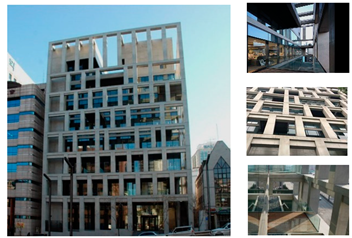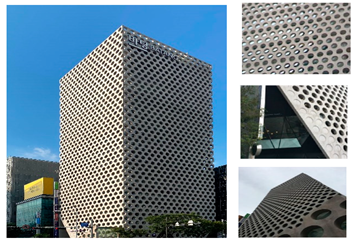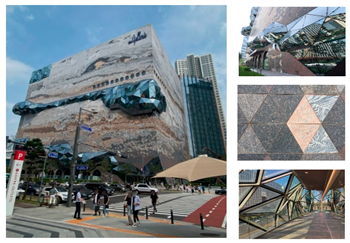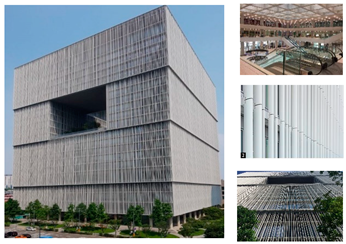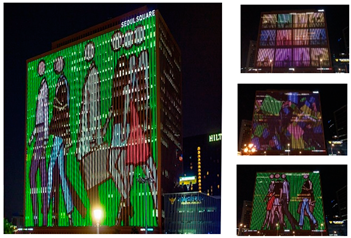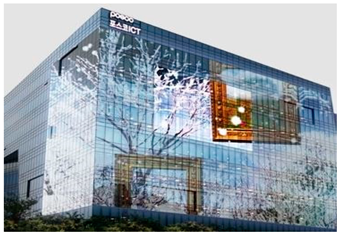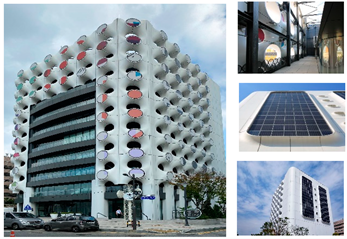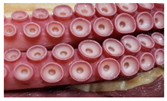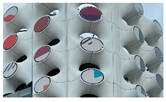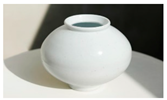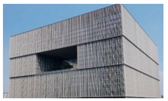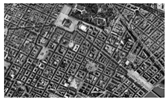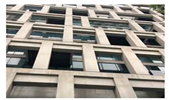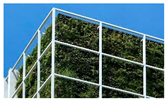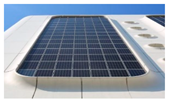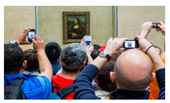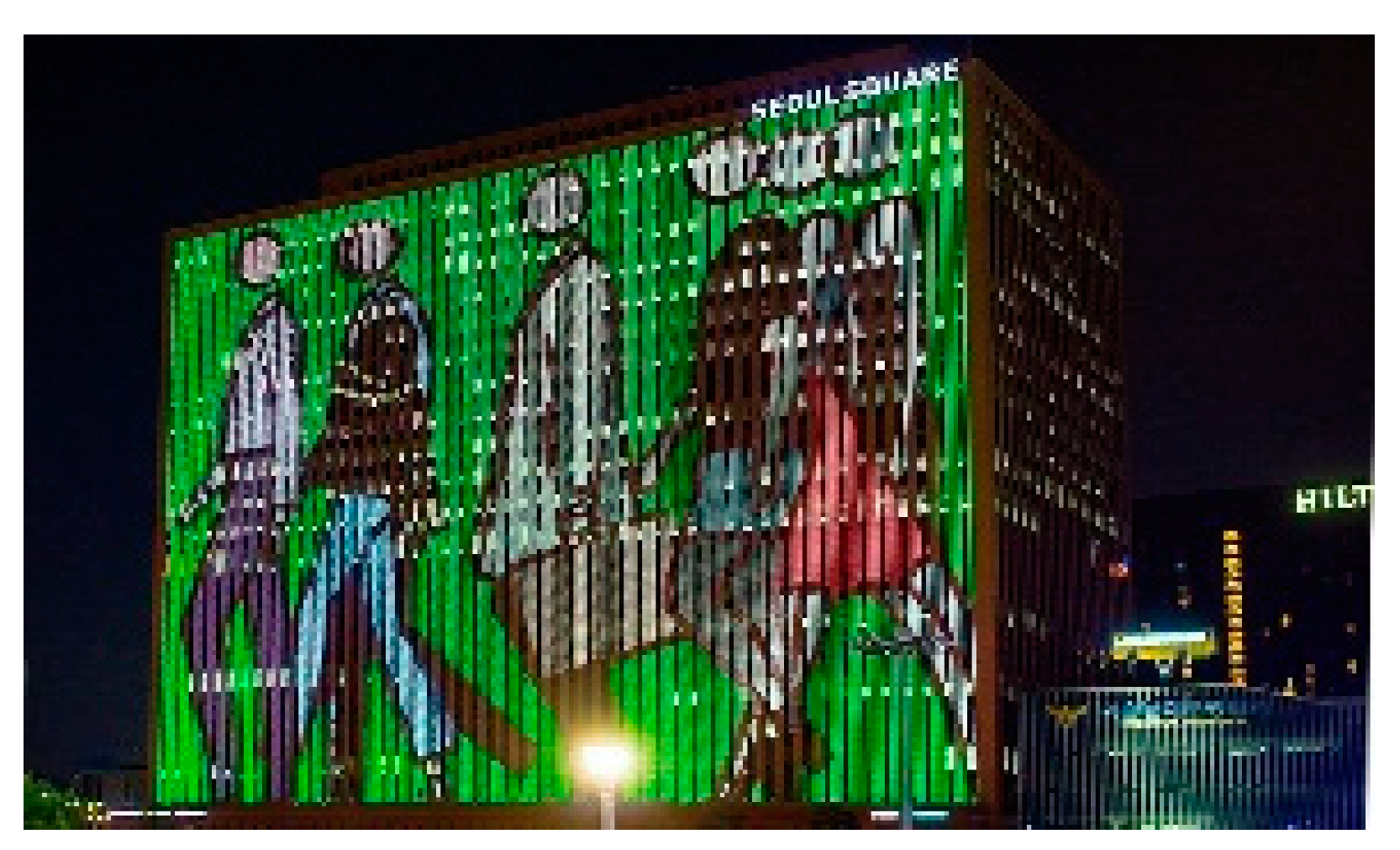Abstract
Various facade designs in modern architecture have expanded the limits of materials and construction methods. In this study, I explored and analyzed structural, decorative, media, and adaptive as representative case studies of facade expression. This study identified the following modern architectural trends for new facade construction methods in South Korea. First, efforts to improve the function of spaces by integrating interior and exterior spaces. Second, attempts for creating decorative facade expressions that stimulate human senses, or expand perceptions and increase aesthetic sense. Third, forming complementary relationships with the city by demonstrating regionality. Fourth, enhancing the performance of facades with adaptive facades. Fifth, helping to expand publicness, such as strengthening and combining the relationships between city, building, and person. Changes and advances in architectural facades will ultimately enhance fundamental aspects of architecture, enriching our daily living through harmony between the traditional and the modern, buildings and humans, and buildings and the environment.
1. Introduction
Following the Industrial Revolution, the development of new construction techniques, such as reinforced concrete and steel structures, has allowed facades to become independent of the inner structure. These liberated facades have had several effects: new relationships are being formed with internal spaces, for example, blurring the boundary between interior and exterior as well as expanding the intermixing of internal and external spaces; the pursuit of free surface topology to produce new experiences and expand sensibilities is stimulating people’s senses [1]. In the second half of the 20th century, architecture has experienced a period of extreme linguistics, aesthetics, and semantics, as well as technical innovation ([2], p. 46). By accepting new techniques based on electronic information such as digital media and networks, new materials and methods of expression are being attempted. In this way, architects are moving beyond traditional methods of using conventional exterior materials and are attempting novel types of surface expression that reflect generational demands from visual, psychological, and perceptual perspectives. Media surfaces, urban screens, and digital technologies in relation to urban communication make architecture visible and perceptible, and they are thought to be communicating social, cultural, or political messages ([3], p. 38).
Over the same period, facade systems began to be designed with the aim of reducing the energy consumption of buildings, in addition to improving their comfort and sustainability. In particular, facade systems have been transformed from passive technological solutions to active systems that are able to produce energy from renewable sources ([4], p. 66).
Green walls are considered as part of environmental and social criteria and are held at the same level of aesthetics. These contemporary design criteria provide a new social conception of the building sector. They also enhance environmental concepts that consider the whole life of materials, energy, and water consumed throughout the constructional, operational, and end-of-life processes of a building ([5], p. 229). Green walls also optimize the benefits from sites’ renewable energy resources (e.g., daylight). Kinetic facades are installed with the aim of ensuring occupant comfort by compensating for climatic fluctuations ([6], p. 187).
Biomimicry is a field of science that aims to solve human problems through the study of natural designs. Since nature has the ability to adapt to environmental changes, we can make buildings sustainable and environmentally adaptive by mimicking the systems of living organisms and, more generally, nature ([7], p. 322).
In the present study, focusing on modern architecture in South Korea, I analyzed the trends of sensitive expression in facade design, which has an important effect on changes in a facade’s architectural functionality, energy efficiency, and environmental sustainability. The objective was to explore the new values and possibilities in facades in modern Korean architecture that can meet expectations related to human sensibilities, efficiency, and sustainability while also representing the era.
2. Materials and Methods
To explore the new values and possibilities in facades in modern Korean architecture, a literature review process as a tool for conducting potentially relevant literature to the research topic was applied in this study. The main databases used for the relevant articles search were Auric (Architectural City Research Information Center, Korea, www.auric.co.kr (9 December 2020), Google Scholar, and Scopus. The following step in this paper was to provide a brief background of the concept, meaning, and patterns of expression in modern architecture facades.
Through my review of the existing literature and previous research, I investigated the new modern architectural trends for expression in facades in South Korea. Subsequently, I selected and analyzed case studies across different aspects covering several recent facades of urban buildings, such as those integrating structural elements (structural facades), artistic expression through facades (decorative facades), facades as media using optical technology (media facades), and the adaptive facade. The results of my analysis allowed me to discuss the value of these novel experiments with facades in contemporary South Korean architecture, as well as the trends for expression in Korean contemporary architectural facade design.
2.1. The Concept and Meaning of Facades in Modern Architecture
A facade is a tool for constructing the overall image of a building. The materials composing the facade are traditionally based on regional characteristics and are constructed using local materials, labor, and techniques, thus imbuing these structures with the stories and history of the era [8]. Facades can be broadly divided into two types. For the first type, the building and the facade are fused together; most pre-modern-era facades used this method, where the walls themselves are the structure and the medium for artistic representation. For the second type, the building and the facade are completely separated; following the Industrial Revolution, the development of new construction techniques such as reinforced concrete and steel structures has enabled the facade to be separated from the building as an independent, autonomous concept. Thenceforth, these liberated facades have begun to be perceived as independent and superficial [9].
2.2. Patterns of Expression in the Facades of Modern Architecture
Facades were traditionally built more robustly to account for waterproofing, insulation, and impact resistance. However, facades in modern architecture have moved beyond conventional inner and outer materials (Figure 1a), and may use a soft outer structure that considers visual and tactile decorative effects, as an example (Figure 1b) ([10], p. 34). Technological developments have expanded the limits of materials and construction techniques; the production of new materials, new methods of use, and changes in construction techniques are blurring boundaries within the domains of culture and art. New, creative designs are being attempted that are imbued with narrative and painterly sensibilities. Through constant experimentation, new concepts of facades are being generated. For example, there have been diverse and complex efforts at expression based on a digital environment and advances in information communications technology, of which media facades (Figure 1a) are one example. In the near future, the building industry will have to make a meaningful contribution to the protection of ecosystems, recognizing the importance of environmentally friendly construction, and making efforts to design ecological surfaces (Figure 1d) through techniques such as the adaptive facade [2] (p. 44).

Figure 1.
New trends for facades in modern architecture. Source: Public domain.
2.2.1. Structural Facades
Previously in architecture, facades formed essential relationships with the structure, explicitly displaying the construction logic and expressing the structure itself, or being determined by spatial functions. Since the early 20th century, facades have gained autonomy from the structure, and the concept of independence has emerged, meaning that the external appearance and internal structure can be incongruent. In modern times, there has been a trend for “structural facades”, in which an idealized structure, the formative expression of structure, and the combination of construction and aesthetics are used to eliminate additional columns indoors and expose the building to the outside. Architecture using structural facades targets structural completeness and logic, and breaks down the boundary between internal and external, producing a novel spatial concept [11].
2.2.2. Decorative Facades
In architecture, decorative facades appeal to people’s senses and emotions through original attempts to provide multisensory experiences, scale, symbolism, movement and change, atypical shapes, methods of using construction materials, and varied expressions of physical properties; they represent experiments with facades that enable novel experiences through all five senses [12]. These original efforts at experimental facades are not only giving birth to a new spatial concept that generates unique physical and somatic behaviors, but are also contributing to epochal representation that provides an aesthetic and artistic expression of the region and era [13].
2.2.3. Media Facades
Accompanying the development of digital and information communications technology, media has been overlaid on the surface of buildings for information delivery or communication with passersby. The term “media facade” refers to the installation of LEDs or other lighting on the walls of a building and the use of video control or network technology on the lighting to produce enormous images. The initial media facades generally used electronic billboards or text to convey information to passersby. In contrast, contemporary media facades send/receive and depend on data via computers or ubiquitous environments; they sometimes even create a “virtual space”, sensing or reacting to visitors to enable bidirectional information transfer and communication [14]. The ability to make prompt, diverse changes to the content liberates facades from their traditional concepts and roles, and media facades are continuing to develop and produce content oriented to the current era.
2.2.4. Adaptive Facades
The shape and composition of architectural facades not only has a major impact on construction and maintenance costs, but also greatly affects the health and comfortable living of occupants. Numerous environmentally friendly functions need to be considered when planning a facade for a building, including shade, ventilation, energy, materials, and greenification. Adaptive facades, including the greenification of walls and rooftops, provide color, noise reduction, air purification, and indoor humidity control; they can reduce energy expenditure by lowering the wall temperature and also help to convert the congested, artificial urban environment into a pleasant urban environment that contains nature, is aesthetically attractive, and harmonizes with the surrounding environment [15]. Adaptive facades can also enhance trust and value in companies and organizations through symbolic marketing strategies. In addition to their aesthetic functions, adaptive facades can help to clarify spatial zoning and protect privacy via screening/concealment, as well as define movement paths and perform a symbolic role by creating shapes and volumes in space. In this way, adaptive facades in modern architecture help to restore the harmonious relationship between humans and nature [16].
In fact, the application of green facades helps to reduce energy use and indoor air pollution, and improves the built environment’s aesthetics and building occupants’ quality of life ([5], p. 173). Since nature has the ability to adapt to environmental changes, we can make buildings sustainable and environmentally adaptive by mimicking the systems of living beings and nature. With biomimetic facades in the field of architecture, numerous projects mimic the physical and behavioral properties of animals and plants [7] (p. 319). Occupant visual and thermal comfort significantly depend on exterior environmental climatic conditions, which are continuously changing. Kinetic facades make it possible to optimize visual and thermal comfort simultaneously ([6], p. 186).
3. Case Studies of Facade Design in Modern Architecture in South Korea
In the literature review process, new concepts of facades were examined. To derive the trends of expression in facades in modern Korean architecture, I selected two case studies (Table 1) for each of the new trends described above (structural, decorative, media, and adaptive facades). Each case was built between 2008 and 2020 in urban centers. Most of these projects received design awards for their contribution to contemporary architectural design with innovative ideas.

Table 1.
Case studies.
The KHVatec office building and Urban Hive received the Seoul Architecture Award for their innovative use of structural facade design and contributions to urban center revitalization. Gwanggyo Galleria Department Store and Amorepacific headquarters and their facade design are representative of Korea’s traditional and geological characters in architecture. Seoul Square is the first large-scale media facade architecture project that has been considered as public art. Smart Tower is the first large-scale building with a pedestrian-sensitive media facade system in Korea. PLACE 1 and Seogwipo City Hall received the architectural award for their innovative adaptive facade concepts with green and kinetic facade systems.
This study analyzed the effects of these new facade designs on the architectural space, aesthetic, regionality, function, and publicness. Key architectural elements show where and how each building affects urban and human life. The assessment of these elements is indicated with Excellent ●, Good ◐, or Poor ○.
3.1. Structural Facade Case Studies
3.1.1. KHVatec Office Building (A)
The KHVatec office building in Seocho-gu, Seoul (Table 2) [17], is a building with four underground floors and eight above-ground floors; the spaces between the structures have been left empty to enable future vertical expansion. The exposed concrete structure is open to the outside, and the interior was planned as a column-free space. The shape of the externally exposed structure uses the motif of electronic components, which are the main products of the company; thus, the surface reflects the company’s image. By readjusting the spacing and density of the frame to show similarity to the immediately adjacent buildings, the design minimizes discordance with the existing street context. In the spaces between the interior and exterior, there are two terraces per floor, which not only act as structural bridges connecting the main building with the facade structure, but also provide potential rest areas.

Table 2.
Structural facades: KHVatec office building (THE_SYSTEM LAB 2010). Key: Excellent ●, Good ◐, Poor ○.
3.1.2. Urban Hive (B)
The Urban Hive in Gangnam-gu, Seoul (Table 3) [18], is a building with 4 underground floors and 17 above-ground floors. Adopting the beehive structure, which is the sturdiest structure in the insect world, the building was conceptualized as a “beehive in the heart of the city”, using an exposed concrete structure with innumerable holes. This unique outer wall is not a decorative skin but is a “structural facade” acting as a structural element. As this design makes the outer wall simultaneously an aesthetic and a structural element, the interior can be used as a column-free space, which allows more freedom in the spatial composition of the interior and is also effective for ventilation and shade. Even though the overall building has a simple cuboidal shape, the unique and dramatic surface design gives the building a powerful presence, even in a region with a large number of high-rise buildings.

Table 3.
Structural facades: Urban Hive (Archium 2008).
3.2. Decorative Facade Case Studies
3.2.1. Gwanggyo Galleria Department Store (C)
The Gwanggyo Galleria Department Store in Suwon-si, Gyeonggi-do (Table 4) [19], is a large building consisting of 7 underground floors and 12 above-ground floors. Using sediment as a motif, the distinctive outer wall expresses the textures and colors of sedimentary layers, while harmonizing with the natural environment. The outer wall uses a mixture of glass and stone (granite); the glass part starts at the main entrance on the first floor and meanders up to the rooftop in a helical shape. This breaks away from the conventional department store formula of windowless designs, and the space inside the band of glass, which is in the form of a stepped terrace, is filled by a diverse array of programs. All floors of the department store receive natural light and are used as spaces for various activities, including special events, exhibitions, and talks (Gwanggyo Galleria Department Store design concept, https://oma.eu/ (9 December 2020). The stone curtain wall is constructed from 120,000 tiles of 14 different types of granite rock that are precisely joined like a mosaic to represent the geological strata and rocks in the earth.

Table 4.
Decorative facades: PLACE1 (OMA/GANSAM 2020).
3.2.2. Amorepacific Headquarters (D)
The Amorepacific headquarters in Yongsan-gu, Seoul (Table 5) [20], is an office building for a cosmetics company with 7 underground floors and 22 above-ground floors. The underground area consists of open spaces that can be used freely by anyone and provide different forms of culture and services. To contribute to the urban landscape in a bustling area packed with high-rise buildings, this building was designed with the concept of a traditional Korean “moon jar”, which embodies tranquility and the refined beauty of pure white. To construct a multifunctional space with diverse areas, the massing is in the form of a traditional hollow moon jar, with the volume expanding in four stages, creating a massive cube in a courtyard that gradually grows with increasing height. All the curtain walls not only regulate solar radiation but also use vertical aluminum louvers in the image of traditional folding screens to represent the imagery of the pure white jar.

Table 5.
Decorative facades: Amorepacific headquarters (David Chipperfield/Haeahn Architecture 2017).
3.3. Media Facade Case Studies
3.3.1. Seoul Square (E)
Located opposite Seoul Station, the major train station in South Korea, Seoul Square (Table 6) [21] consists of 2 underground floors and 23 above-ground floors. The construction was completed in 1977, and the building served as a landmark in Seoul for a long time, until it was renovated in 2009 due to aging, including space enhancements and a media facade. The upper floors are leased offices, while the lower floors are used by various retail outlets and cultural facilities. By applying a media facade, the previously oppressive and stiff surface has been transformed into a space that offers creative inspiration within the city through light and art displays. The issue of the media facade being used as a simple advertising board has been resolved, and now it is even perceived as a form of public art. Accordingly, in the process of negotiating with the building owner, Seoul City has agreed to limit the display on the media facade to artistic works, including media art, and a certified contemporary art gallery operates the facade.

Table 6.
Media facades: Seoul Square (Junglim Architecture/iArc 2009).
3.3.2. Smart Tower (F)
Located in Seongnam-si, Gyeonggi-do, Smart Tower (Table 7) [22] contains 7 underground floors and 22 above-ground floors. It is used as the headquarters of Posco ICT, a media and landscape lighting company. The front face of the building is a glass curtain wall (70 m tall, 33 m wide) fitted with 260,000 LEDs and can display high-resolution (HD) images or videos. Applying image segmentation technology for the first time in South Korea, the facade is used for corporate advertisements, news, and art videos, as well as proposals and participatory events for citizens and passersby, thereby communicating with the street and injecting vitality into the city.

Table 7.
Media facades: Smart Tower (Posco A&C 2011).
3.4. Green Facade Case Studies
3.4.1. PLACE1 (G)
PLACE1 in Gangnam-gu, Seoul (Table 8) [23], is an office building for a bank consisting of 4 underground floors and 10 above-ground floors. It also contains open spaces that can be used freely by the public and provide various services and cultural facilities. Kinetic facade and biomimetic facade concepts have been applied in this project. Since nature has the ability to adapt to environmental changes, buildings become sustainable and environmentally adaptive by mimicking the systems of living beings and nature and affect comfort conditions with control of climatic changes.

Table 8.
Adaptive facades: PLACE1 (THE_SYSTEM LAB 2017).
The facade consists of an inner glass curtain wall and an outer structure made of 178 pieces of UHPC (ultra-high-performance concrete) resembling octopus suckers. The space between the inner and outer layers is used for terraces. Each sucker-shaped outer piece is fitted with a round disk, which has a diameter of 2 m; the 178 disks are a form of “kinetic architecture” that rotate using solar energy to regulate solar radiation and ventilation. With this aesthetic facade utilizing biological form and function, it provides the design with a sense of vitality, as if the building were a living organism.
3.4.2. Seogwipo City Hall (H)
Located in Seogwipo-si, Jeju-do, a region in Korea where the natural environment is well preserved, Seogwipo City Hall is an office building (Table 9) [24] consisting of two underground floors and six above-ground floors. The upper floors are office spaces for the city hall workers, while the lower floors are open spaces for citizens, including cultural facilities. To maximize the publicness of the city hall and encapsulate the surrounding cultural context and natural landscape, wall greenification was used as part of a surface plan employing natural elements. This resulted in a form of architecture that is harmonized with nature, revitalizing the old, lagging city center. By placing diverse vegetation native to Jeju-do, wall greenification was made easier to maintain, while attempting to restore nature to the city via the diversification of the landscape and botanical environment.

Table 9.
Adaptive facades: Seogwipo City Hall (Sun Architects 2016).
4. Discussion: Analysis of Trends for Expression in Korean Contemporary Architectural Facade Design
The trends for facade expression in modern architecture in South Korea observed in the case studies above can be summarized as follows.
Structural facades are idealized structures that generate a new concept of space. They break down the boundaries between interior and exterior to create free indoor spaces and improve functions such as ventilation and shade. In addition, by turning a structure into an aesthetic element, these designs can reflect the company’s image on the surface, emphasize the weight of the materials, or impose a powerful presence through bold surfaces that give a light and vivacious feeling to the exposed concrete surfaces, which can otherwise appear heavy and stiff. Regarding design motive, the application of biomimetics through applying regional and urban character to the facade allows diversifications to expand.
Decorative facades can express regional and epochal characteristics, and can elevate architecture to an aesthetic art by using imagery from other artistic domains (e.g., painting, sculpture) or adopting traditional local techniques or regional geological images to stimulate human artistic sensibilities. Thus, diversifications are also expanded.
Media facades utilize media combined with computers or a ubiquitous environment to convey information or exchange data with or react to and sense viewers/passersby, in order to achieve bidirectional communication and generate “virtual spaces.” Architects began to look beyond the screen towards urban space and became interested in the experimental spirit typical of artists. The facade, combined with digital technology, creates a new image in a monotonous urban environment, plays a role as a mediator in the digital age, and connects and communicates with people and the external environment [25].
With the ability to make constant changes to the content, these designs liberate architectural facades from their traditional roles and concepts. Seoul Square and Smart Tower act as parts of public art, providing creative inspiration to the city through light and art. In addition, they show the tendency towards “aphysicalization” that transcends the physical aspects of solid, fixed, and traditional architectural surfaces. In other words, as the facade is a soft, dynamic membrane that guarantees low weight and transparency, these designs demonstrate the potential for organic superficial structures that operate through various means of manipulation and expression.
Adaptive facades enhance environmental performance by air purification, noise/humidity regulation, and wall cooling. In the early stages, simple green walls were installed on building facades; later, more diverse adaptive facades (e.g., kinetic facades) started to be installed on buildings. They also helped to change congested, artificial urban environments to be more natural and aesthetic, creating pleasant urban environments that harmonize with the surrounding natural environment. By including nearby natural and cultural context and landscapes in buildings and increasing the environmental friendliness, publicness is improved because users and pedestrians are provided with a pleasant environment. These designs also increase the facades’ symbolism and can improve recognition of the facilities or have a positive marketing effect based on the environmentally friendly image.
Based on the indices of space, aesthetic, regionality, function, and publicness in the case studies (Table 10), I analyzed the trends for expression in modern office architecture facades in South Korea (Table 11). From the results of this analysis, the trends can be summarized as “use of space to help set new relationships of space through integration and linkage between the inner and outer spaces”, “use of aesthetic elements to stimulate the senses through expanded visual imagery, and to provide the experimental amusement of biomimetic sculpting”, “expression of regionality”, “enhanced performance of facades”, and “reinforcing communication through expanded public access”.

Table 10.
Trends of expression for each assessed element. Key: Excellent ●, Good ◑, Poor ○.

Table 11.
Trends of expression for each assessed element.
4.1. Space: Helping to Set New Spatial Relationships through the Integration and Linkage of Inner and Outer Spaces
“Structural facades”, “adaptive facades”, and “media facades” have been used in attempts to enhance the functions of spaces by setting new spatial relationships through the integration and linkage of the inner and outer spaces and imagery. For example, this could be achieved by creating transitional spaces between the inner and outer layers, which could be used as rest areas, or by introducing outer spaces (e.g., nature) inside the building, or by expanding the interior design concepts and imagery to the outside.
4.2. Aesthetic: Stimulation of the Senses through the Expansion of Visual Imagery and the Experimental Amusement of Biomimetic Sculpting
“Decorative facades” and “adaptive facades” show efforts at aesthetic facade expressions that stimulate human sensibilities or expand perception and increase aesthetic sense. This might be achieved by an original and emotive expression that imbues the materials with narrative elements and conversational qualities through the mixture and integration of materials, the acceptance of expressive techniques from other fields (e.g., the arts), and the unconventional use of materials that are uncommon in architecture. Through special application of regionalism (e.g., local tradition), nature expressions are expanded.
4.3. Regionality: Representing Regional Characteristics by Reflecting the Human and Physical Context as Well as Reinforcing Relationships with the City and the Broader Region
In design motive, material uses, and adoption of technology, “structural facades”, “decorative facades”, and “adaptive facades” implicitly express the physical relationship with the surrounding city, including climate and context, and the human environment, including the region’s history, culture, and traditions, forming imagery and a complementary relationship with the city.
4.4. Function: Improving the Performance of Facades by Adopting Forms and Functions from Nature and Other Objects
“Adaptive facades” show efforts at facade expression that enhance the direct functions of facades, such as ventilation, shade, insulation, noise reduction, and aesthetic appearance, by producing direct wall greenification and kinetic facade. From early-stage green walls to later kinetic facades, facade performance has been improved by adopting integrated IT systems, mechanical actuators, and innovative materials. These are able to transform the envelope from a static element into a dynamic function so that static and physical requirements [4] are expanded.
4.5. Publicness: Communication and Reinforcing Relationships with the City through Public Access. Facades Are Recognized as Public Property and Used as Brand Marketing
“Media facades” and “adaptive facades” have given fluidity to architectural surfaces that traditionally had physically fixed designs and have now become usable as a medium for information delivery and communication. Facades are present in the changes regarding the city’s physical aspects and the role of culture in the public environment. Media architectural surfaces can be useful means to stimulate the public and invite them to have a deeper cultural sensibility [3]. In addition, the environmental friendliness of streets and building interiors/exteriors has been improved by the direct introduction of the ecological environment to facades, such as wall greenification. The result is improved publicness and higher brand value, as the building blends in and synchronizes with the city and environment, making it more accessible to users and pedestrians, and the relationships between city, building, and humans are strengthened and combined.
5. Conclusions
With technological advances, various facade designs in modern architecture have expanded the limits of materials and construction methods. They are generating novel facade concepts through continuous experimentation, such as the production of new materials, new methods of use, and changes to construction methods. In this study, I explored and analyzed structural, decorative, and media facades using scientific technology, and adaptive facades as representative case studies of facade expression. I identified the following modern architectural trends for new facade construction methods in South Korea.
First, in the early stages of facade, trend efforts were made to improve the function of structures by integrating interior and exterior spaces (structural facade) and simply applying greenification on a facade, both for aesthetic reasons and for reducing the heating level of a building. In later stages, facades began to be installed with the aim of improving overall space performance; this means not only integrating outdoor and indoor spaces, but also engaging the overall building environment.
A second trend involves attempts to create decorative facade expression that stimulates the human senses through original and emotive expression, or expands perceptions and increases aesthetic sense.
Third, early stages of facade design trends focused on international and general design issues, while later stages form complementary relationships with the city by demonstrating regionality, starting to show how technology should be combined with regionality.
Fourth, early stages of trends in facade design concentrated on enhancing the shape and aesthetic of facades by referring to the organic forms and functions of animals and plants. Later stages of facade trends began to demonstrate how to apply the performance of organic forms and functions into the building envelope.
A fifth trend sees facade design aiming to help to expand publicness, strengthening and combining the relationships between city, building, and person. Changes and advances in architectural facades will ultimately enhance fundamental aspects of architecture, enriching our daily living through the harmony between the traditional and the modern, buildings and humans, and buildings and the environment, as well as through improved spatial functions. Early stages of media facades only presented digital images, while later stages identified the potential to attract people toward these new urban landmarks, accordingly influencing people’s attachment towards such urban spaces [26].
In this regard, I hope that continued research on the new facade experiments discussed in this study will contribute to mature spatial expression and development that reflects the era. I would like to recommend further studies on the different effects of facades on people’s interest and intention towards them, especially utilizing these new-found attributes to develop an environmental psychology model about people’s perception towards this kind of modern urban element. The results gained from this study are expected to help designers increase the attraction towards buildings in Korea to engage more researchers, thus creating new nocturnal landmarks in urban spaces.
Funding
This research was funded by Wonkwang University Research Fund of 2020.
Institutional Review Board Statement
Not applicable.
Informed Consent Statement
Not applicable.
Conflicts of Interest
The author declares no conflict of interest.
References
- Jung, M. Architecture as representation of corporeality—From G. Semper’s Bekleidung to Herzog & de Meuron’s Surface. J. Archit. Hist. Korea 2005, 14, 107–122. [Google Scholar]
- Francesca, S. Adaptive Facade and Phase Change Materials (PCMS) A sustainable Approach for Building Materials; From Mega to Nano, The Complexity of a Multiscalar Project; Palermo University Press: Palermo, Italy, 2020; pp. 44–69. [Google Scholar]
- Katia, G. Media-surface design for urban regeneration: The role of colour and light for public space usability. J. Int. Colour Assoc. 2017, 17, 38–49. [Google Scholar]
- Romano, R.; Aelenei, L.; Aelenei, D. What is an adaptive façade? analysis of recent terms and definitions from an international perspective. J. Facade Des. Eng. 2018, 6, 65–76. [Google Scholar]
- Farid, F.H.; Ahmad, S.S.; Raub, A.B.; Shaari, M.F. Green “Breathing facades” for occupants’ improved quality of life. Soc. Behav. Sci. 2016, 234, 173–184. [Google Scholar] [CrossRef][Green Version]
- Hosseinia, S.M.; Mohammadia, M.; Rosemannb, A.; Schröderc, T.; Lichtenbergc, J. A morphological approach for kinetic façade design process to improve visual and thermal comfort. Build. Environ. 2019, 153, 186–204. [Google Scholar] [CrossRef]
- Wajiha, T.S.; Quratulain, A. Adaptive biomimetic facades: Enhancing energy efficiency of highly glazed buildings. Front. Archit. Res. 2019, 8, 319–331. [Google Scholar]
- Kim, J.; Kim, J. A Study on the expression aspects of the contemporary architecture for the development of placeness. Korean Inst. Spat. Design. 2012, 23, 98–100. [Google Scholar]
- Kwon, H.R.; Kim, H.J. A study on expressivity of contemporary architectural surface by material properties. J. Korean Soc. Des. Cult. 2017, 23, 37–50. [Google Scholar] [CrossRef]
- Oh, S. A study on the expressivity of covering and exposing of architecture surface after modern architecture. J. Korea Inst. Inter. Des. 2014, 23, 34–35. [Google Scholar]
- Shin, Y. A study on the skin construction of 『Prada Aoyama Tokyo』 through the functional relation of structure-skin. J. Korea Acad. Ind. Coop. Soc. 2013, 14, 5208–5209. [Google Scholar]
- An, J.G. A study on the sensitivity expression of architectural facade design. Korean Inst. Spat. Des. 2006, 01, 31–37. [Google Scholar]
- Yu, J. A study on the re-interpretating the expressive property in exterior envelope of architecture. J. Archit. Inst. Korea 2003, 19, 181–183. [Google Scholar]
- Kim, J. Analysis of preference survey for the media facade cases according to the sensibility keywords. J. Korea Inst. Inter. Des. 2013, 22, 28–29. [Google Scholar]
- Ban, J.; Lee, E. Exploring environment-friendly potential within the skin of green libraries. Korea Inst. Ecol. Archit. Environ. J. 2019, 19, 66–67. [Google Scholar]
- Jung, H.; Lee, H. An analysis of the repetition pattern in green facade focusing on the biophilic design. J. Korea Inst. Inter. Des. 2016, 25, 82–83. [Google Scholar]
- THE_SYSTEM LAB. KHVatec Office Building. 2010. Available online: https://thesystemlab.com/361 (accessed on 9 December 2020).
- Archium. Urban Hive. 2008. Available online: https://www.archium.co.kr/2009-junior-u-1 (accessed on 9 December 2020).
- OMA/GANSAM. Gwanggyo Galleria Department Store. 2020. Available online: http://www.gansam.com/project/projects_all_view/index/1687/24/MTI=/c0FyZWE=/c1llYXI=//?page=1 (accessed on 9 December 2020).
- David Chipperfield/Haeahn Architecture. Amorepacific Headquarters. 2017. Available online: http://www.haeahn.com/ko/project/detail.do?prjctUseSeq=8&addr=&prjctServiceSeq=&prjctListSeq=0&prjctSeq=1434&searchKeyword=&searchCondition= (accessed on 9 December 2020).
- Junglim Architecture/iArc. Seoul Square. 2009. Available online: http://www.junglim.co.kr/works/design/349/view (accessed on 9 December 2020).
- Posco A&C. Smart Tower. 2011. Available online: https://www.poscoanc.com/kr/portfolio/view.do (accessed on 9 December 2020).
- THE_SYSTEM LAB. PLACE 1. 2017. Available online: https://thesystemlab.com/558 (accessed on 9 December 2020).
- Sun Architects. Seogwipo City Hall. 2016. Available online: http://www.suning.co.kr/home/m_view.php?ps_db=Projcet&ps_boid=55 (accessed on 9 December 2020).
- Cha, M. A Study on application examples of media façade by technology case and content type. J. Digit. Art Eng. Multimed. 2018, 5, 175–184. [Google Scholar] [CrossRef]
- Moghaddam, E.V.; Ibrahim, R. People’s evaluation towards media façade as new urban landmarks at night. Int. J. Archit. Res. 2016, 10, 257–273. [Google Scholar] [CrossRef]
Publisher’s Note: MDPI stays neutral with regard to jurisdictional claims in published maps and institutional affiliations. |
© 2021 by the author. Licensee MDPI, Basel, Switzerland. This article is an open access article distributed under the terms and conditions of the Creative Commons Attribution (CC BY) license (https://creativecommons.org/licenses/by/4.0/).








